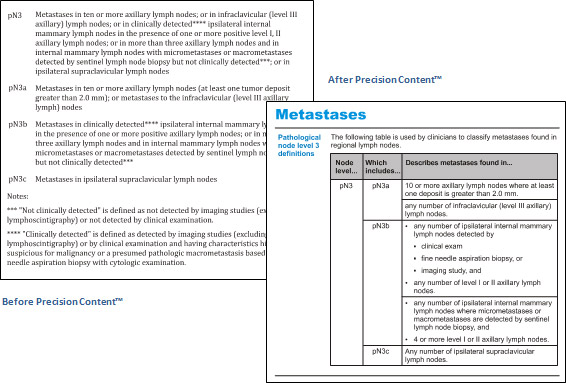
What is the Precision Content® Writing Methodology?
Beyond Words: Transforming Content into a Strategic Business Asset
Content is the lifeblood of any organization — a vital business asset that provides meaning, direction, and stability both for internal and external users alike.
As organizations grow, the challenge of maintaining accurate, usable content grows at an exponential pace. This is a problem that can’t be solved simply by hiring more content producers or throwing more effort at the problem.
Without empowering content producers with proper systems and a consistent writing methodology, businesses that pour well-intentioned hours into developing content are doomed to face:
- Inconsistent and outdated content
- Duplication of efforts with no single source of truth
- Content that cannot be used cross-platform and cannot scale
- Inefficiency and waste
What is the Precision Content Writing Methodology?
Precision Content® is a method of planning, authoring, and publishing high-value, structured content. It is a robust and systematic content life-cycle solution that helps enterprises manage content as a corporate asset. Precision Content makes content more precise.
This approach can be applied to most business and technical content but is most often applied to
- product documentation
- user manuals
- policies and procedures
- learning and training content, and
- help and support content.
How can the Precision Content Writing Methodology help your organization?
The Precision Content Methodology breaks content down into its component parts making it easier to read and understand.
Our approach saves your organization time and money in the activity of content authoring, content management and content publishing.
This enables you and your team to start managing your content like an asset, allowing you to unlock benefits such as:
| Feature | Benefit |
| Improved content quality, accuracy, and consistency | Improved readability and ease of use |
| Future-proofing | Modular, well-structured content is primed for the next phase of your information management strategy. Whether publishing to a mobile device or upgrading to a state-of-the-art content management system, clear, well-designed and semantically aware content is the first step. |
| Reducing update and approval time | Making updates and approving content is easier when content is well structured and easy to find and keep track of. Using structured content reduces content approval time and effort. |
| Reusing information | Topics can be used in multiple information products such as a content set, a help system, context-sensitive help, a training curriculum, a website, or a mobile app. |
| Using content as a valuable asset | XML makes content intelligent, versatile, manageable, and portable. Content can be published to PDF, HTML, RTF, PowerPoint, or mobile all without ever copying and pasting anything between files.
Compared to traditional authoring and content life-cycle approaches, Precision Content unearths unrealized efficiencies and cost savings and provides strategies for managing content as a valuable asset. |
Before & After
Here are before and after examples of content transformed using Precision Content:
- A medical journal excerpt, and
- A transformation example explained in detail.
Key Advantages
These are the key advantages of Precision Content:
 Adapted structured authoring methodology
Adapted structured authoring methodology
Precision Content adapts structured authoring best practices to a rich semantically-structured technology framework. Teams of authors and contributors are trained to produce modular, concise, and consistent content. This is critical to developing effective, scalable, and sustainable content.
 Interoperability of XML
Interoperability of XML
Precision Content is based on DITA – the fastest growing open XML standard in the world. You are free to choose the best tools for your content lifecycle. There’s no vendor lock-in, ever.
 Multi-channel publishing and future-proofing
Multi-channel publishing and future-proofing
Backed by an XML infrastructure, you can publish to all the formats and devices you need including web, PDF, wiki, Microsoft SharePoint, Microsoft Word, RTF, ePub, and many others. Better yet, you are future-proofing your content for whatever formats or requirements you might need next year or even 10 years from now.
 Guided single-source authoring in a collaborative environment
Guided single-source authoring in a collaborative environment
Authoring becomes an established method that results in amazingly usable, high-quality content. It is also not prone to errors and inconsistencies introduced by copy and paste. Once a piece of content exists, it can be reused as many times as needed. Updating it in one place updates it everywhere.
Three laws
These are the three laws that support the content strategy.
| Element | Basis | Benefits |
| Utility |
|
|
| Maintainability |
|
|
| Usability |
|
|
Learn the Precision Content method
Learn effective methods to write clear, concise, well-structured content with our specialized online training program.
Choose the training package that fits your needs and learn structured writing strategies that will transform your organization.
Learn more about the Precision Content Writer Training Program or Contact us today.
Trademark: “Precision Content” is registered with the U.S. Patent and Trademark Office and with the Canadian Intellectual Property Office.



 Adapted structured authoring methodology
Adapted structured authoring methodology Interoperability of XML
Interoperability of XML Multi-channel publishing and future-proofing
Multi-channel publishing and future-proofing Guided single-source authoring in a collaborative environment
Guided single-source authoring in a collaborative environment
 April 8-10, 2024
April 8-10, 2024


